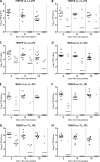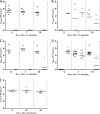Impaired fitness and transmission of macrolide-resistant Campylobacter jejuni in its natural host
- PMID: 22183170
- PMCID: PMC3294946
- DOI: 10.1128/AAC.05516-11
Impaired fitness and transmission of macrolide-resistant Campylobacter jejuni in its natural host
Abstract
Campylobacter jejuni is a major zoonotic pathogen transmitted to humans via the food chain and is prevalent in chickens, a natural reservoir for this pathogenic organism. Due to the importance of macrolide antibiotics in clinical therapy of human campylobacteriosis, development of macrolide resistance in Campylobacter has become a concern for public health. To facilitate the control of macrolide-resistant Campylobacter, it is necessary to understand if macrolide resistance affects the fitness and transmission of Campylobacter in its natural host. In this study we conducted pairwise competitions and comingling experiments in chickens using clonally related and isogenic C. jejuni strains, which are either susceptible or resistant to erythromycin (Ery). In every competition pair, Ery-resistant (Ery(r)) Campylobacter was consistently outcompeted by the Ery-susceptible (Ery(s)) strain. In the comingling experiments, Ery(r) Campylobacter failed to transmit to chickens precolonized by Ery(s) Campylobacter, while isogenic Ery(s) Campylobacter was able to transmit to and establish dominance in chickens precolonized by Ery(r) Campylobacter. The fitness disadvantage was linked to the resistance-conferring mutations in the 23S rRNA. These findings clearly indicate that acquisition of macrolide resistance impairs the fitness and transmission of Campylobacter in chickens, suggesting that the prevalence of macrolide-resistant C. jejuni will likely decrease in the absence of antibiotic selection pressure.
Figures




Similar articles
-
Development, stability, and molecular mechanisms of macrolide resistance in Campylobacter jejuni.Antimicrob Agents Chemother. 2008 Nov;52(11):3947-54. doi: 10.1128/AAC.00450-08. Epub 2008 Sep 8. Antimicrob Agents Chemother. 2008. PMID: 18779354 Free PMC article.
-
Effect of macrolide usage on emergence of erythromycin-resistant Campylobacter isolates in chickens.Antimicrob Agents Chemother. 2007 May;51(5):1678-86. doi: 10.1128/AAC.01411-06. Epub 2007 Mar 12. Antimicrob Agents Chemother. 2007. PMID: 17353243 Free PMC article.
-
Impact of erythromycin resistance on the virulence properties and fitness of Campylobacter jejuni.Microb Pathog. 2011 Jun;50(6):336-42. doi: 10.1016/j.micpath.2011.02.009. Epub 2011 Mar 4. Microb Pathog. 2011. PMID: 21377522
-
The Current State of Macrolide Resistance in Campylobacter spp.: Trends and Impacts of Resistance Mechanisms.Appl Environ Microbiol. 2017 May 31;83(12):e00416-17. doi: 10.1128/AEM.00416-17. Print 2017 Jun 15. Appl Environ Microbiol. 2017. PMID: 28411226 Free PMC article. Review.
-
Fluoroquinolone-resistant Campylobacter in animal reservoirs: dynamics of development, resistance mechanisms and ecological fitness.Anim Health Res Rev. 2003 Dec;4(2):63-71. doi: 10.1079/ahr200356. Anim Health Res Rev. 2003. PMID: 15134291 Review.
Cited by
-
Genomic diversity and fitness of E. coli strains recovered from the intestinal and urinary tracts of women with recurrent urinary tract infection.Sci Transl Med. 2013 May 8;5(184):184ra60. doi: 10.1126/scitranslmed.3005497. Sci Transl Med. 2013. PMID: 23658245 Free PMC article.
-
Antibacterial Activity of 2-(3',5'-Dibromo-2'-methoxyphenoxy)-3,5- dibromophenol Isolated from Phyllospongia papyracea.Nat Prod Commun. 2017 Apr;12(4):567-569. Nat Prod Commun. 2017. PMID: 30520598 Free PMC article.
-
Genetic Basis and Clonal Population Structure of Antibiotic Resistance in Campylobacter jejuni Isolated From Broiler Carcasses in Belgium.Front Microbiol. 2018 May 17;9:1014. doi: 10.3389/fmicb.2018.01014. eCollection 2018. Front Microbiol. 2018. PMID: 29867900 Free PMC article.
-
Mutational and transcriptomic changes involved in the development of macrolide resistance in Campylobacter jejuni.Antimicrob Agents Chemother. 2013 Mar;57(3):1369-78. doi: 10.1128/AAC.01927-12. Epub 2012 Dec 28. Antimicrob Agents Chemother. 2013. PMID: 23274667 Free PMC article.
-
Campylobacter spp. isolated from poultry in Iran: Antibiotic resistance profiles, virulence genes, and molecular mechanisms.Food Sci Nutr. 2022 Nov 21;11(2):1142-1153. doi: 10.1002/fsn3.3152. eCollection 2023 Feb. Food Sci Nutr. 2022. PMID: 36789060 Free PMC article.
References
-
- Aarestrup FM, McDermott PF, Wegener HC. 2008. Transmission of antibiotic resistance from food animals to humans, p 645–665 In Nachamkin I, Szymanski CM, Blaser MJ. (ed), Campylobacter, 3rd ed ASM Press, Washington, DC
-
- Allos BM. 2001. Campylobacter jejuni infections: update on emerging issues and trends. Clin. Infect. Dis. 32:1201–1206 - PubMed
-
- Almofti YA, Dai M, Sun Y, Haihong H, Yuan Z. 2011. Impact of erythromycin resistance on the virulence properties and fitness of Campylobacter jejuni. Microb. Pathog. 50:336–342 - PubMed
-
- Altekruse SF, Tollefson LK. 2003. Human campylobacteriosis: a challenge for the veterinary profession. J. Am. Vet. Med. Assoc. 223:445–452 - PubMed
-
- Andersson DI. 2003. Persistence of antibiotic resistant bacteria. Curr. Opin. Microbiol. 6:452–456 - PubMed
Publication types
MeSH terms
Substances
Grants and funding
LinkOut - more resources
Full Text Sources
Medical
Molecular Biology Databases

